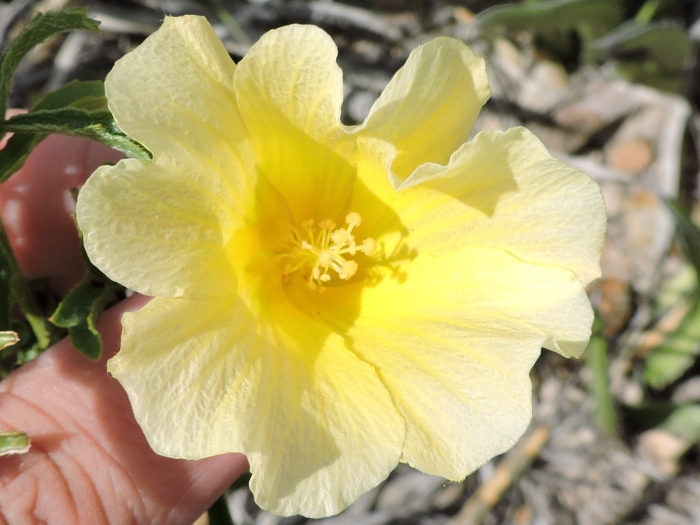Desert Rosemallow
(Hibiscus coulteri)
Desert Rosemallow (Hibiscus coulteri)
/
/

Sam Kieschnick
CC BY 4.0
Image By:
Sam Kieschnick
Recorded By:
Copyright:
CC BY 4.0
Copyright Notice:
Photo by: Sam Kieschnick | License Type: CC BY 4.0 | License URL: http://creativecommons.org/licenses/by/4.0/ | Rights Holder: Sam Kieschnick | Publisher: iNaturalist | Date Created: 2016-08-24T02:59:59-07:00 |






























Estimated Native Range
Summary
Hibiscus coulteri, commonly known as Desert Rosemallow, is a deciduous subshrub or shrub native to arid regions, including desert washes and rocky slopes in the Southwestern United States and Northern Mexico. It typically grows to a height of 1-4 feet (0.3-1.2 meters) and a width of 1-3 feet (0.3-0.9 meters). The plant has a sprawling habit with deeply lobed leaves and produces large, showy flowers with five pale yellow petals and a contrasting white center. These blooms appear in the warmer months of spring, summer, and fall, attracting pollinators such as bees and hummingbirds.
Desert Rosemallow is valued for its drought tolerance and its ability to thrive in challenging environments, making it an excellent choice for xeriscaping and naturalistic plantings in arid climates. It is also used for erosion control on slopes and in restoration projects. Gardeners appreciate its low water needs and adaptability to various soil types, from sandy to loamy, as long as they provide good drainage. While it can tolerate part shade, full sun exposure encourages the most prolific flowering. It is generally free from serious pests and diseases, but root rot can occur in poorly drained soils.CC BY-SA 4.0
Desert Rosemallow is valued for its drought tolerance and its ability to thrive in challenging environments, making it an excellent choice for xeriscaping and naturalistic plantings in arid climates. It is also used for erosion control on slopes and in restoration projects. Gardeners appreciate its low water needs and adaptability to various soil types, from sandy to loamy, as long as they provide good drainage. While it can tolerate part shade, full sun exposure encourages the most prolific flowering. It is generally free from serious pests and diseases, but root rot can occur in poorly drained soils.CC BY-SA 4.0
Plant Description
- Plant Type: Subshrub, Shrub
- Height: 1-4 feet
- Width: 1-3 feet
- Growth Rate: Moderate
- Flower Color: Yellow
- Flowering Season: Spring, Summer, Fall
- Leaf Retention: Deciduous
Growth Requirements
- Sun: Full Sun, Part Shade
- Water: Low
- Drainage: Slow, Medium, Fast
Common Uses
Bee Garden, Bird Garden, Butterfly Garden, Hummingbird Garden, Low Maintenance, Rock Garden
Natural Habitat
Native to arid regions, including desert washes and rocky slopes in the Southwestern United States and Northern Mexico
Other Names
Common Names: Desert Rose-Mallow, Coulter’s Hibiscus
Scientific Names: , Hibiscus coulteri, Hibiscus coulteri var. brevipedunculata,
GBIF Accepted Name: Hibiscus coulteri Harv. ex A.Gray